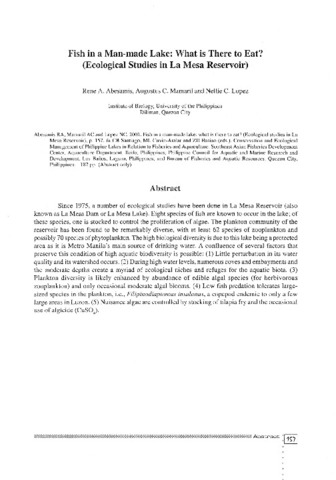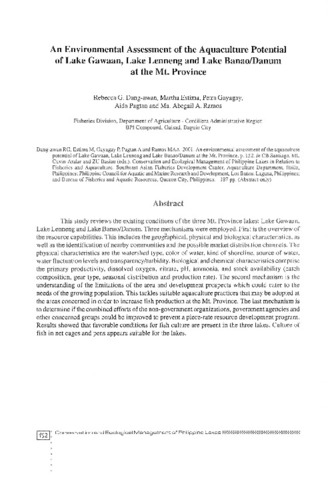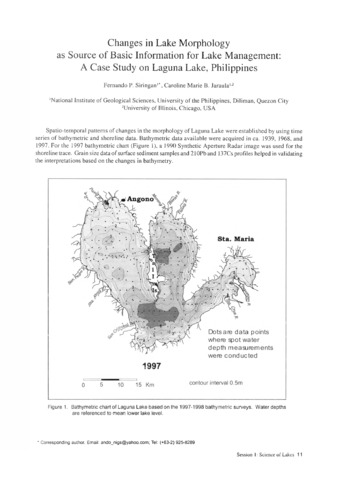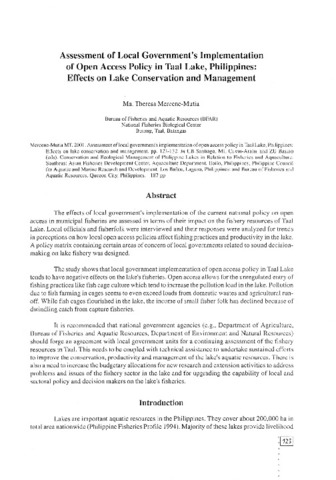Fish in a man-made lake: what is there to eat? (Ecological studies in La Mesa Reservoir)
| dc.contributor.author | Abesamis, Rene A. | |
| dc.contributor.author | Mamaril, Augustus C. | |
| dc.contributor.author | Lopez, Nellie C. | |
| dc.date.accessioned | 2012-01-19T11:05:04Z | |
| dc.date.available | 2012-01-19T11:05:04Z | |
| dc.date.issued | 2001 | |
| dc.identifier.citation | Abesamis, R. A., Mamaril, A. C., & Lopez, N. C. (2001). Fish in a man-made lake: what is there to eat? (Ecological studies in La Mesa Reservoir) (Abstract only). In C. B. Santiago, M. L. Cuvin-Aralar, & Z. U. Basiao (Eds.), Conservation and Ecological Management of Philippine Lakes in Relation to Fisheries and Aquaculture (p. 157). Tigbauan, Iloilo, Philippines: Aquaculture Department, Southeast Asian Fisheries Development Center; Los Baños, Laguna, Philippines: Philippine Council for Aquatic and Marine Research and Development (PCAMRD), Department of Science and Technology; Quezon City, Philippines: Bureau of Fisheries and Aquatic Resources (BFAR), Department of Agriculture, Quezon City, Philippines. | en |
| dc.identifier.isbn | 9718511539 | |
| dc.identifier.uri | http://hdl.handle.net/10862/839 | |
| dc.description | Abstract only. | en |
| dc.description.abstract | Since 1975, a number of ecological studies have been done in La Mesa Reservoir (also known as La Mesa Dam or La Mesa Lake). Eight species of fish are known to occur in the lake; of these species, one is stocked to control the proliferation of algae. The plankton community of the reservoir has been found to be remarkably diverse, with at least 62 species of zooplankton and possibly 70 species of phytoplankton. The high biological diversity is due to this lake being a protected area as it is Metro Manila's main source of drinking water. A confluence of several factors that preserve this condition of high aquatic biodiversity is possible: (1) Little perturbation in its water quality and its watershed occurs. (2) During high water levels, numerous coves and embayments and the moderate depths create a myriad of ecological niches and refuges for the aquatic biota. (3) Plankton diversity is likely enhanced by abundance of edible algal species (for herbivorous zooplankton) and only occasional moderate algal blooms. (4) Low fish predation tolerates large-sized species in the plankton, i.e., Filipinodiaptomus insulanus, a copepod endemic to only a few large areas in Luzon. (5) Nuisance algae are controlled by stocking of tilapia fry and the occasional use of algicide (CuSO4). | en |
| dc.language.iso | en | en |
| dc.publisher | Aquaculture Department, Southeast Asian Fisheries Development Center | en |
| dc.publisher | Philippine Council for Aquatic and Marine Research and Development (PCAMRD), Department of Science and Technology | en |
| dc.publisher | Bureau of Fisheries and Aquatic Resources | en |
| dc.subject | Philippines, Luzon I., La Mesa L. | en |
| dc.title | Fish in a man-made lake: what is there to eat? (Ecological studies in La Mesa Reservoir) | en |
| dc.type | Conference paper | en |
| dc.citation.spage | 157 | |
| dc.citation.conferenceTitle | Conservation and Ecological Management of Philippine Lakes in Relation to Fisheries and Aquaculture: Proceedings of the National Seminar-Workshop held on October 21-23, 1997, INNOTECH, Commonwealth Ave., Diliman, Quezon City, Philippines | en |
| dc.subject.asfa | artificial lakes | en |
| dc.subject.asfa | freshwater ecology | en |
| dc.subject.asfa | freshwater lakes | en |
| dc.subject.asfa | plankton | en |
| dc.subject.asfa | species diversity | en |
| dc.subject.asfa | water quality | en |
| dc.subject.asfa | water reservoirs | en |
| dc.subject.scientificName | Filipinodiaptomus insulanus | en |





